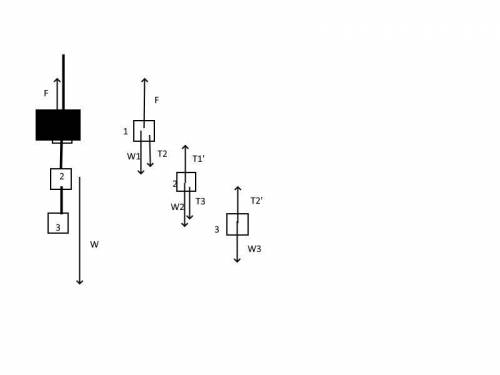
Physics, 28.02.2021 16:50, xandraeden32
A student suspends a chain consisting of three links, each of mass m 0.250 kg, from a light rope. The rope is attached to the top link of the chain, which does not swing. She pulls upward on the rope, so that the rope applies an upward force of 9.00 N to the chain.
a. Draw a free-body diagram for the entire chain, considered as a body, and one for each of the three links. (b) Use the diagrams of part (a) and Newton's laws to find (i) the acceleration of the chain, (ii) the force exerted by the
top link on the middle link, and (iii) the force exerted by the middle link on the bottom link. Treat the rope as massless.
1. There are four objects of interest in this problem: the chain as a whole and the three individual links. For each of these four objects, make a list of the external forces that act on it. Besides the force of gravity, your list should include only forces exerted by other objects that touch the object in question.
2. Some of the forces in your lists form actionâreaction pairs (one pair is the force of the top link on the middle link and the force of the middle link on the top link). Identify all such pairs.
3. Use your lists to help you draw a free-body diagram for each of the four objects. Choose the coordinate axes.
4. use your lists to decide how many unknowns there are in this problem. Which of these are target variables?
EXECUTE
5. Write a Newton's second law equation for each of the four objects, and write a Newton's third law equation for each actionâreaction pair. You should have at least as many equations as there are unknowns (see step 4). Do you?
6. Solve the equations for the target variables.
EVALUATE
7. You can check your results by substituting them back into the equations from step 6. This is especially important to do if you ended up with more equations in step 5 than you used in step 6.
8. Rank the force of the rope on the chain, the force of the top link on the middle link, and the force of the middle link on the bottom link in order from smallest to largest magnitude. Does this ranking make sense? Explain.
9. Repeat the problem for the case in which the upward force that the rope exerts on the chain is only 7.35 N. Is the ranking in step 8 the same? Does this make sense?

Answers: 1
Other questions on the subject: Physics

Physics, 21.06.2019 16:30, victorialeona81
Bone-strengthening physical activity done increases bone-mineral content and bone density in youth.
Answers: 1

Physics, 22.06.2019 00:40, naomicervero
The rigid beam is supported by the three suspender bars. bars ab and ef are made of aluminum and bar cd is made of steel. if each bar has a cross-sectional area of 450 mm2, determine the maximum value of p if the allowable stress is (σallow)st = 200 mpa for the steel and ( σallow)al = 150 mpa for the aluminum. est = 200 gpa and eal = 70 gpa.
Answers: 1


Do you know the correct answer?
A student suspends a chain consisting of three links, each of mass m 0.250 kg, from a light rope. Th...
Questions in other subjects:

History, 13.01.2021 18:20


History, 13.01.2021 18:20

Arts, 13.01.2021 18:20

Mathematics, 13.01.2021 18:20



History, 13.01.2021 18:20

Social Studies, 13.01.2021 18:20

Mathematics, 13.01.2021 18:20



 - g (1)
- g (1)





